| |
|
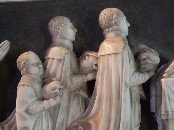 |
|
The area to the north of
Bury St Edmunds is not noted for its
natural beauty. Here beyond the
industrial area is where Bury's
warehousing is pushed along the sleeves
of the roads to Mildenhall, Thetford and
Diss, and the dull Breckland scrub with
its scattering of pine copses is home to
acres and acres of pigs, the great
agricultural enthusiasm of West Suffolk
in these early years of the 21st Century.
Perhaps pigs and warehouses are all that
make money these days. But
you don't need to go far from the main
roads to find another West Suffolk, that
of secretive, self-contained little
villages, with beautiful little churches.
Ampton is one.
|
I
have never been very fortunate with visits to
this church. In half a dozen attempts over a
period of ten years or so, I had never found it
open, and never had an answer to my calls to the
keyholders. In any case, the key is several miles
off in another village, and when you are on a
bike that's a long way to call on the chance of
someone being in, especially when the phone isn't
being answered. However, coming here in early
2008, I took a note of the address, and found the
house quite by chance later that day while
visiting another church.
Some
weeks later, I came back, and went to the house
first. A very kind man came and opened up for me,
and so it was that I was able to see inside this
beautiful building for the very first time.
The
church is small, and sits pointing towards the
village street. Opposite, behind the wall, is the
massive pile of Ampton Hall, rebuilt after a fire
in the 1890s. St Peter and St Paul is attractive
enough, especially in Holy Week with the
daffodils pushing up around the cross of a grave
to the east of the church, but on walking around
it you discover something quite unusual, a
chantry chapel set off of the north side of the
nave. It dates from the later years of the 15th
century, and was established by John Coket. It
was served by its own Priest, who would often
celebrate while the Parish mass was being said in
the chancel, an insight into the way in which
many medieval churches operate, although most of
those with chantries were larger than this one.
St
Peter and St Paul underwent a very early
Victorian restoration, at the hands of the
maverick Samuel Teulon. The first impression on
stepping inside is that not much has happened
since. This is a delightfuly ramshackle interior,
with the rustic smell of age and an endearing
shabbiness. So many parish churches must have
been like this once.
What
is most striking about the interior, and this is
accentuated because it is such a small church, is
the number and size of memorials. Mostly, there
are to members of the Calthorpe family,
successors to the Cokets at Ampton Hall. Dorothy
Calthorpe, on the south wall, kneels in piety
behind her prayer desk, like Mary at the
Annunciation. Her inscription records that this
virgin foundress of the almshouse left this life
for a better... in the 45th year of her age. A
virgin votary is oft in snares, this safely
vow'd, and made the poor her heirs.
The
two grandest memorials are on the north wall of
the chancel. The most spectacular is to Henry
Calthorpe and his wife, and a prominently placed
cartouche records in Latin that John and
Matthias, the Christmas Brothers, made it in
1638. Mr and Mrs Calthorpe sit patiently as if in
a box at the opera, but it is the smaller figures
beneath that catch the eye. Their children kneel
either side of a prayer desk, weeping in sorrow -
but almost every single one of them carries a
skull, denoting that they died before their
parents. What a sobering thought.
Beside
it is the memorial by Nicholas Stone to William
Whetall. He was the father of Mrs Calthorpe, and
died at about the same time, in 1630.
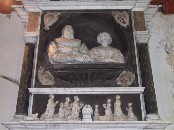 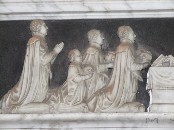 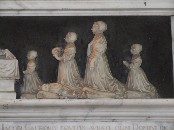 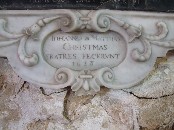
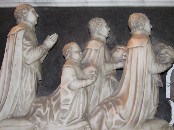
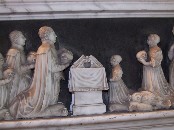
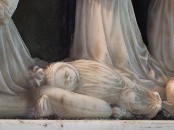 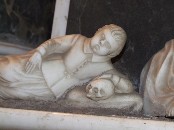
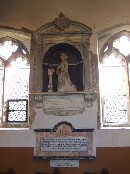 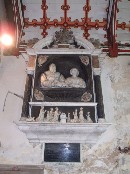
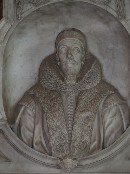 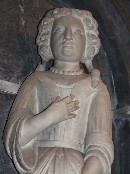
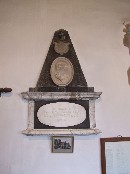
Memories
of modern Ampton are maintained by the east
window, and the entrance to the Coket chantry.
The window tracery dates from Teulon's
restoration, but the glass records the
destruction of Ampton Hall by fire, and the
inscription tells us that it was given in
grateful memory of January 3rd 1885,
because, although the Hall was completely
destroyed, no lives were lost. The three sons of
the family are shown as Shadrach,
Meshach, and Abednego, alive in the Fiery
Furnace. The window depicts the risen Christ
flanked by four Saints, St Peter and St Paul, the
church patrons, and the East Anglians St Edmund
and St Etheldreda. Mortlock says it is by
Burlison and Grylls, and it is very good, looking
the work of perhaps twenty years later.
The chantry chapel entrance
is surmounted by the inscription Capella Perpetue
Cantarie Joh'is Coket - the perpetual Chantry
Capel for John Coket. But he could not know that
it would all come to an end in a few short
decades. The flanking niches were set with
beautiful mosaics in the early 1920s. That to the
west depicts St Christopher, and remembers that
the rebuilt Ampton Hall was used as a military
hospital during World War One. More than six and
a half thousand wounded were treated there; the
names of the forty who died are recorded on the
north wall of the chantry chapel. That to the
east depicts St George, and is in memory of
Lieutenant Bernard Wickham MC, the only son of
the Rector. He won his Military Cross on the
Somme, and was killed in the Third Battle of
Ypres in April 1917. He was just 22 years old.
The chantry chapel itself
retains some medieval glass in the west window,
including a roundel with a sacred monogram. There
is a curiosity to the east of the entrance, a
square recess. Couldit have been a reliquary to
the chantry altar?
Set
in the tower arch is an unusual fretwork royal
arms for Charles I, roughly contemporary with the
work of Christmas and Stone in the chancel.
Either side of the tower arch are two elaborate
consecation crosses peeping from behind broken
plaster.
| Between the two ends of the
church, however, St Peter and St Paul has
more of a flavour of rural Victorians,
and of the great Anglo-catholic
enthusiasms of the early years of the
20th century. It is at once a time
capsule and a treasure house. Presumably,
some day, there will be an enthusiastic
churchwarden who will take it to task.
He'll have the walls painted, the old
iron stove removed, the floor tiles
relaid flat and the windows cleaned, and
the shades and shadows will all flee away
to be replaced by a dull domesticity. So
enjoy it while you can, it is wonderful.
|
|
 |
|
|
|

